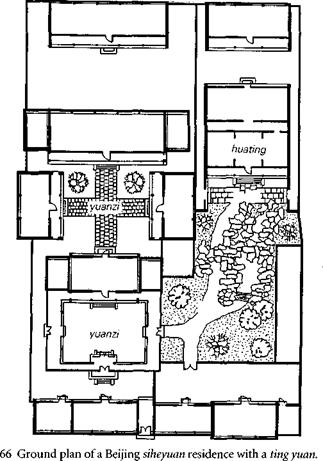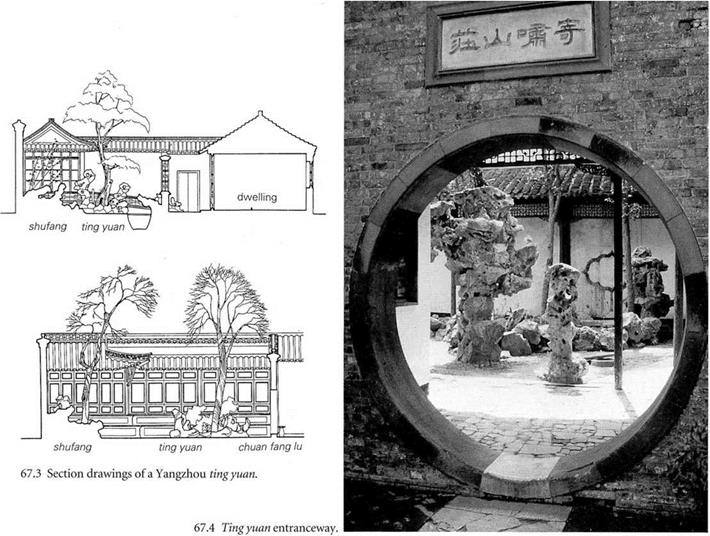![]()
![]()
![]()

Ting Yuan, Prototype of the Yuanlin
The hall and courtyard (ting) in Chinese dwellings form one unified, functional, everyday living space. In some homes there is also another important area associated with the residential complex, a ting yuan or yuanlin landscape garden, which is distinctly partitioned off from the hall/ courtyard portion of the dwelling.
The yuanlin is a small landscape park, which was enlarged and developed from the ting yuan, a contemplative landscape garden.
The ting yuan is composed of small buildings—a shu – fang (study), chafang (drawing room) or huating (banquet hall)—and gardens surrounded by a retaining wall; it abuts with the exterior wall surrounding the residential area, but differs totally in nature from the residential ting (courtyard) space (Figure 66).
A total of eight residences with ting yuan in Yangzhou, and two in Huizhou, were surveyed, and in all, the residential area—composed of woshi, tang and tianjing—is separated by a surrounding wall from the annexed shu – fang or chafang and their corresponding garden scenes composed of plants and arrangements of unusual rocks;

this annexed area is in turn surrounded by a retaining wall. This structure shows that Chinese gardens did not emerge from a connection to everyday living, but rather in a sphere apart from the functional and mundane. The chafang and huating (rooms for entertaining guests) and the shufang (study) were built outside the living area. The ting yuan was always set apart as an object for admiration.
The independent shufang, chafang, and huating were found only in the homes of the literati, warriors, government officials, and the nouveau riche, and so were clear indicators of social position. To qualify as an elite space, the ting yuan had to be distinctly partitioned off from the mundane spaces of the home. And as an object for con
templation, it set out to give tangible form to a vision of utopia, like the circumstances and spirit portrayed in Chinese landscape painting.
The ting yuan is a hua yuan (literally, “flower garden”; the term used in reference to ornamental gardens), which differs greatly from the ting (which is written with the character used for “niwa,” or garden, in Japanese.)
In contrast to the yuanzi and the tianjing, which are functional, outdoor living spaces, the ting yuan is purely a pleasure garden, with no everyday functions. Hence it is usually not visible from the residential area; alternatively, it may be partially visible through latticework windows. The residential compound is totally divorced from the
|
|
|


ting yuan, separated by retaining walls surrounding both spaces, and a narrow alleyway (chuan feng lu) running between them (Figures 67.1-67.5).
Smaller ting yuan have a shufang or a chafang in one corner, together with a garden scene composed of plants, rock arrangements, or a pond corresponding to the viewing position from the main seat inside (Figure 68.1). Larger ting yuan contain opposing huating, two halls facing one another from opposite sides of the garden with corresponding scenery at the center (Figure 68.2), or a Mandarin Duck huating (one central hall separated by an interior wall creating back-to-back halls, each facing out onto different garden scenes; Figure 68.3).
The shufang, chafang, and huating form the core of the ting yuan’s meaning as a symbol of elitism, and their corresponding garden scenes contain utopian expressions of the same quality as those seen in Chinese landscape painting. The ting yuan stands as the antithesis of the ting, in the sense that it is an independent space with no direct relation to daily living.



